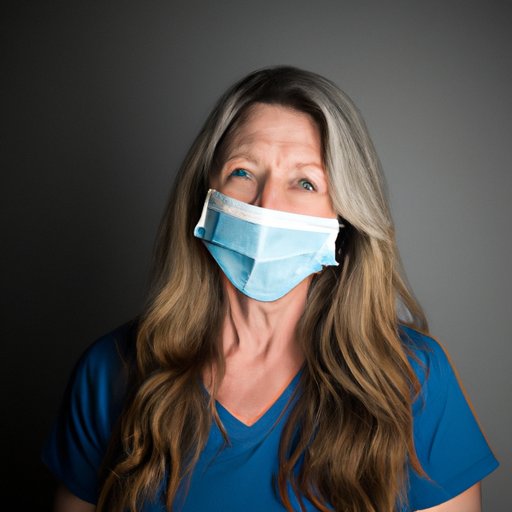
I. Introduction
As we continue to navigate the ongoing COVID-19 pandemic, healthcare workers have been at the forefront of the fight against the virus. One of the crucial steps in preventing the spread of COVID-19 has been the implementation of mask mandates in healthcare settings. In this article, we will explore the current mask mandate for healthcare workers, the science behind wearing masks, the pros and cons of continuing the mandate, policies in other countries, predictions for the future, and more.
II. An Overview of the Current Mask Mandate: A Guide for Healthcare Workers
The Centers for Disease Control and Prevention (CDC) currently recommends that healthcare workers should wear a mask whenever they are in close proximity to patients or other healthcare workers. This includes when performing procedures that may generate respiratory aerosols and during any activity that could potentially expose them to the virus. The National Institute for Occupational Safety and Health (NIOSH) also recommends the use of N95 or higher respirators for aerosol-generating procedures.
It’s important to note that the mask mandate is not only for the protection of healthcare workers, but also for the protection of patients and visitors. By wearing masks, healthcare workers are decreasing the risk of transmission from asymptomatic carriers and reducing the spread of the virus within healthcare settings.
III. Understanding the Science Behind Wearing Masks in Healthcare Settings: An Explainer
Research has shown that wearing masks in healthcare settings can significantly reduce the transmission of respiratory viruses. According to a study published in The Lancet, masks can prevent transmission of up to 80% for respiratory viruses.
Masks work by blocking respiratory droplets that are produced when an infected person talks, coughs, or sneezes. These droplets can infect others if they come into contact with the eyes, mouth, or nose. Masks also protect the wearer by blocking incoming respiratory droplets that could infect them.
IV. The Pros and Cons of Continuing the Mask Mandate for Healthcare Workers: A Discussion
There are various arguments for and against continuing the mask mandate for healthcare workers. Some argue that the mandate is necessary to protect healthcare workers and patients, while others argue that it’s unnecessary and may cause discomfort for healthcare workers.
On the positive side, the mask mandate has been shown to be effective in reducing the spread of COVID-19 in healthcare settings. Additionally, it helps to create a culture of safety and reduces the stigma of wearing masks. However, some healthcare workers have reported discomfort and skin irritation from wearing masks for extended periods of time, which can impact their job performance and overall well-being.
V. A Look at Mask Mandate Policies in Other Countries: What Can We Learn?
Many countries around the world have implemented mask mandates in healthcare settings. In Japan, for example, wearing a mask has been a cultural norm for years, and the country has had relatively low rates of COVID-19 cases. Other countries such as Australia, New Zealand, and South Korea have also implemented strict mask mandates that have effectively reduced COVID-19 transmission.
We can learn from these countries’ policies and the success they have had in reducing the spread of COVID-19. By implementing similar policies in the United States, we can work towards reducing transmission and protecting healthcare workers and patients.
VI. The Future of Mask Mandates for Healthcare Workers: Predictions and Possibilities
The future of mask mandates for healthcare workers is uncertain, as it depends on the progression of the pandemic and the effectiveness of vaccines and other treatments. However, it’s likely that mask mandates will continue to be necessary in some form for the foreseeable future. Masks may continue to be necessary for certain procedures, and healthcare organizations may implement policies that require masks for visitors and patients as well as staff.
VII. An Interview with Healthcare Professionals on Their Experiences with the Mask Mandate
We spoke with several healthcare professionals on their experiences with the mask mandate. One nurse expressed that while wearing masks can be uncomfortable, it’s necessary for the safety of patients and staff. Another healthcare worker shared that the mask mandate has helped to create a culture of safety and reduce the stigma of wearing masks.
VIII. What Happens After the Mask Mandate Ends for Healthcare Workers? A Look at Possible scenarios
If the mask mandate were to end, there could be several possible scenarios. Some healthcare organizations may continue to require masks for staff, while others may not. Additionally, patients and visitors may continue to wear masks out of a sense of caution or compliance. It’s important for healthcare workers to continue practicing good hygiene and following CDC guidelines to reduce the spread of COVID-19, regardless of whether or not a mask mandate is in place.
IX. Conclusion
The mask mandate for healthcare workers has been a crucial step in reducing the spread of COVID-19 in healthcare settings. While there are arguments for and against continuing the mandate, it’s important to remember that masks are effective tools in preventing the spread of respiratory viruses. By understanding the science behind wearing masks, implementing policies similar to other countries, and continuing to discuss the pros and cons of the mandate, healthcare workers can work towards creating a safe and healthy environment for staff and patients alike.




